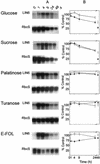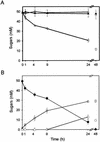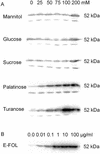Metabolizable and non-metabolizable sugars activate different signal transduction pathways in tomato
- PMID: 11950996
- PMCID: PMC154275
- DOI: 10.1104/pp.010771
Metabolizable and non-metabolizable sugars activate different signal transduction pathways in tomato
Abstract
To gain insight into the regulatory mechanisms of sugar signaling in plants, the effect of derivatives of the transport sugar sucrose (Suc), the Suc isomers palatinose and turanose, and the Suc analog fluoro-Suc were tested. Photo-autotrophic suspension culture cells of tomato (Lycopersicon peruvianum) were used to study their effect on the regulation of marker genes of source and sink metabolism, photosynthesis, and the activation of mitogen-activated protein kinases (MAPKs). Suc and glucose (Glc) resulted in reverse regulation of source and sink metabolism. Whereas the mRNA level of extracellular invertase (Lin6) was induced, the transcript level of small subunit of ribulose bisphosphate carboxylase (RbcS) was repressed. In contrast, turanose, palatinose, and fluoro-Suc only rapidly induced Lin6 mRNA level, whereas the transcript level of RbcS was not affected. The differential effect of the metabolizable and non-metabolizable sugars on RbcS mRNA regulation was reflected by the fact that only Suc and Glc inhibited photosynthesis and chlorophyll fluorescence. The activation of different signal transduction pathways by sugars was further supported by the analysis of the activation of MAPKs. MAPK activity was found to be strongly activated by turanose, palatinose, and fluoro-Suc, but not by Suc and Glc. To analyze the role of sugars in relation to pathogen perception, an elicitor preparation of Fusarium oxysporum lycopersici was used. The strong activation of MAPKs and the fast and transient induction of Lin6 expresssion by the fungal elicitor resembles the effect of turanose, palatinose, and fluoro-Suc and indicates that non-metabolizable sugars are sensed as stress-related stimuli.
Figures





References
-
- Armstrong GM, Armstrong JK. Formae specialis and races of Fusarium oxysporium causing wilt diseases. In: Nelson PE, Tousson TA, Cook RJ, editors. Fusarium: Diseases, Biology, and Taxonomy. PA: The Pennsylvania State University Press, University Park; 1981. pp. 391–399.
-
- Beimen A, Witte L, Barz W. Growth characteristics and elicitor-induced reactions of photosynthetically active and heterotrophic cell suspension cultures of Lycopersicon peruvianum. Mill Bot Acta. 1992;105:152–160.
-
- Bernt E, Bergmeyer HU. d-Fructose. In: Bergmeyer HU, editor. Methoden der Enzymatischen Analyze. 2 Auflage, Weinheim Bergstrasse, Germany: Verlag Chemie; 1970. pp. 1349–1352.
-
- Binkley RW, Ambrose MG, Hehemann DG. Synthesis of deoxyhalogeno sugars: displacement of the (trifluoromethanesulfonyl)oxy(triflyl) group by halide ion. J Org Chem. 1980;45:4387–4391.
-
- Bradford MM. A rapid and sensitive method for the quantitation of microgram quantities of protein utilizing the principle of protein-dye binding. Anal Biochem. 1976;72:248–254. - PubMed
Publication types
MeSH terms
Substances
LinkOut - more resources
Full Text Sources
Other Literature Sources

